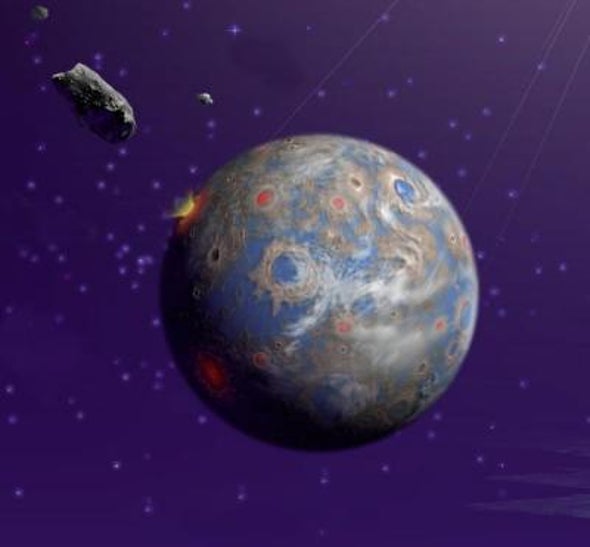(单词翻译:单击)
听力文本
This is Scientific American's 60-second Science, I'm Christopher Intagliata.
In the movie Armageddon, an asteroid the size of Texas is hurtling towards Earth. All seems lost, but then Bruce Willis sacrifices his own life to detonate a thermonuclear bomb on the asteroid. And then you hear this from mission control: "The two halves are gonna miss us by 400 miles, and most of the small particles have been vaporized!"
Breaking a rock that big into two halves, that somehow miraculously dodge the Earth? A bit of Hollywood magic. But scientists are studying what would really happen in such a scenario.
"A big part of what we do is basically looking at how things break. Smashing things together and what happens after that." Charles El Mir is a mechanical engineer who studies planetary science at Johns Hopkins University.
He and his colleagues modeled what might happen if you smashed up a 15-mile-wide asteroid, made of basalt. They started by assuming the asteroid has some tiny cracks already running through it, based on studies of real rock. Then, they struck the hypothetical space rock with another, smaller rock—just a mile wide—hurtling towards the asteroid at more than 11,000 miles per hour. When it hit, they tracked how stress waves propagated through the asteroid, and expanded the network of cracks.

Previous impact models predicted that an impact like that would completely pulverize the asteroid, basically turning it to sand. But not this new model. "What we're seeing, after the impact you have this big chunk of rock that was still held together, still not completely broken down, and this piece of rock creates its own gravitational field which attracts the particles that were ejected from it, and they start re-accumulating over it."
The scientists describe the model in the journal Icarus.
The work suggests asteroids might actually be harder to smash than we thought, meaning: "We might need to have a faster impactor, larger mass of impactor coming in, to be able to deflect it efficiently."
In 2022 NASA's Double Asteroid Redirection Test mission, or DART, will attempt to put all this knowledge to the test, by shoving a near-Earth asteroid off its path. No Bruce Willis required.
Thanks for listening for Scientific American — 60-Second Science. I'm Christopher Intagliata.
参考译文
这里是科学美国人——60秒科学系列,我是克里斯托弗·因塔格里塔。
在电影《世界末日》中,一颗得克萨斯州大小的行星正在冲向地球。似乎一切都会毁灭,但随后布鲁斯·威利斯牺牲了自已的生命,在小行星上引爆了一枚热核炸弹。之后大家听到了来自任务控制中心的声音:“两半巨石将在距地400英里处错过我们,大部分小颗粒已经汽化!”
将一块这么大的石头炸成两半,并使其奇迹般地躲过地球?这有点像是好莱坞的魔法。但科学家正在研究在这种情况下会发生什么。
“我们所做的大部分工作,基本上就是观察物体如何破裂。让物体相互撞击,看看之后会发生什么。”约翰·霍普金斯大学研究行星科学的机械工程师查尔斯·埃尔米尔说到。
他和同事模拟了撞毁一颗15英里宽的玄武岩小行星的情况。依据对真实岩石进行的研究,他们首先假设这颗小行星已经出现一些微小的裂缝。然后,他们用另一块只有1英里宽的较小岩石撞击假设的太空岩石,使其以超过每小时11000英里的速度冲向小行星。在撞击发生时,他们追踪了应力波如何在穿过小行星时传播并扩大裂缝网络。
此前的撞击模型预测,这种撞击会彻底粉碎小行星,基本上会使其变成沙子。但新模型的结果则不然。“我们看到的是,撞击之后仍然有未完全破碎的大块岩石连在一起,这块岩石会产生自已的引力场,吸引从岩石中喷射而出的粒子,然后开始重新聚集。”
科学家在《伊卡洛斯》期刊上描述了这一模型。
这项研究表明,实际上小行星可能比我们想象的更难撞碎,这意味着:“我们可能需要速度更快、质量更大的撞击物,才能有效地使小行星偏转。”
美国国家航空航天局(简称NASA)计划在2022年进行双小行星重定向测试(简称DART),试图通过将近地小行星推离轨道来测试所有这些知识。而这并不需要布鲁斯·威利斯。
谢谢大家收听科学美国人——60秒科学。我是克里斯托弗·因塔利亚塔。
译文为可可英语翻译,未经授权请勿转载!
重点讲解
重点讲解:
1. break into 打碎;砸碎;
Sheets of newly formed sea ice break into pieces under stress of wind and waves.
大块新形成的海冰在风和海浪的作用下裂成碎片。
2. smash up 撞毁;
All you told me was that he'd smashed up yet another car.
你告诉我的事情就是他又撞毁了一辆车。
3. break down 分解;将…分成若干部分;
Even if they break down, they're still works of art.
即使它们破碎了,它们仍然是艺术品。
4. put sth. to the test 使经受检验;对…进行试验;
The Liverpool team are now putting their theory to the test.
利物浦队此时正在验证他们的理论。


